Article prepared by:
Vasily Babkinsky
Doctor of the highest category
Diarrhea combined with chills is a serious symptom. In some cases, treatment must be started immediately. Diarrhea is not an independent disease, but one of the signs of deviation. Indicates a disturbance in the functioning of the gastrointestinal tract. With chills, the patient complains of feelings of cold and heat, as well as muscle tremors. The condition makes you feel worse. Chills and diarrhea together cause severe discomfort. In most cases, symptoms indicate the presence of poisoning. The violation occurs in an acute form. Intoxication may be caused by the ingestion of low-quality products or toxic substances into the body.
The combination of chills with diarrhea is an alarming symptom
Causes of diarrhea in adults
It is clear that diarrhea does not just appear.
And if it is also accompanied by vomiting, then the situation can be critical; you need to find out the cause and take urgent measures. 1. Stress. Chronic or acute stress can lead to diarrhea. Also, diarrhea may appear on the eve of any event; this is a neurotic state. In addition to diarrhea, a person has a severe headache, and if the symptoms do not go away within two days, then they need to contact a neurologist.2. Pregnancy.3. Food poisoning.
May occur from eating low-quality foods. In this case, the stomach tries to remove toxins from the body in any way. Diarrhea and vomiting usually last from a day to three, accompanied by general weakness, sometimes a feverish state.4. Binge eating. After a hearty meal during the holidays, many people often experience vomiting and diarrhea.5. Treatment with certain medications.6. Climate change.
If vomiting and diarrhea without fever appear for all of the above reasons, then the symptoms should subside after three days. If diarrhea and vomiting are accompanied by high fever, and the symptoms have not stopped after three days, then you should immediately go to the hospital.
Diagnostic methods
The examination plan is drawn up based on what other symptoms the patient has. His age, gender, heredity, and concomitant diseases are also taken into account.
But any list of studies for diarrhea against the background of chills includes:
- A clinical blood test that evaluates inflammatory markers: ESR, leukocytes, eosinophils.
- A coprogram or stool test for blood, fat, particles of undigested food, showing in which part of the gastrointestinal tract there is pathology.
- Test for antibodies to helminths.
Functional diagnostics are rarely prescribed, since laboratory tests are more informative and accurate. If there is a need to clarify the diagnosis, the following are prescribed: ultrasound of the abdominal organs, colonoscopy.
Causes of the problem
Nausea and vomiting without fever occurs for various reasons. These include food poisoning, the state of stress in which the patient is, and digestive problems such as diseases of the gastrointestinal tract, dysbiosis and intestinal flu.
Can cause vomiting without fever, hangover, migraine, motion sickness. Sometimes the cause can be determined independently, but if it is not obvious (as, for example, in case of poisoning or hangover), it is better to consult a specialist.
Food poisoning
Food poisoning is accompanied not only by vomiting, but also by diarrhea and fever. However, minor intoxication can cause only one serious symptom in the form of a reflex eruption of stomach contents. Although sometimes the state of poisoning of the body is also accompanied by convulsions, decreased blood pressure, and even loss of consciousness.
Poisoning is caused by ingestion of some inedible or toxic substances and ordinary food products that somehow contain toxic bacteria. Symptoms of poisoning also occur after taking certain medications. The main thing is to identify the cause in time and drink more fluids.
Constant stressful situations in your personal life or during work can lead to the appearance of symptoms similar to signs of poisoning - vomiting and nausea without a change in temperature. This occurs due to the fact that the body activates protective reactions to stress. Sometimes the symptoms are accompanied by severe headaches.
Symptoms often appear in a person shortly before some important event. In most cases, nausea goes away within a few hours or a couple of days. If improvement does not occur on the third day, you should contact a neurologist. Of course, for this you need to be sure of the cause of the problem - in other situations with similar symptoms, specialist help is required much earlier.
Stomach flu
One of the most common diseases that causes vomiting without fever is intestinal flu. You can get it from another infected person - through contaminated food, unwashed hands and household items. Epidemic periods of intestinal flu usually occur in the autumn-winter period.
Additional symptoms of the disease include diarrhea, the frequency of which can reach up to 10 or more times a day. In this case, the stool becomes liquid, has an unpleasant odor and may acquire a greenish tint. Diarrhea causes the body to lose large amounts of fluid, which leads to dehydration.
Gastrointestinal diseases
Vomiting and nausea without fever can also be caused by diseases of the gastrointestinal tract:
- gastritis, additional symptoms of which include general weakness of the body, heartburn and pain in the peritoneum;
- pancreatitis, which can also be recognized by symptoms such as girdle pain extending beyond the left shoulder blade or sternum;
- gastroduodenitis, which usually occurs in an adult either without an increase in temperature or with a slight change in temperature (up to 37–37 degrees), and is accompanied by heartburn, loss of appetite and a feeling of heaviness in the stomach.
Sometimes enterocolitis can develop against the background of other gastrointestinal diseases. Additional symptoms include general weakness and the appearance of mucous or blood in the stool. Treatment for most of these diseases is prescribed after examination by a gastroenterologist, or less often by a surgeon.
Dysbacteriosis
In fact, dysbiosis is not a disease - rather, it is a condition of the body. Its causes are usually:
- long-term use of antibiotics;
- improper diet;
- prolonged (mainly due to lack of normal treatment) stomach upset.
Sometimes the state of dysbacteriosis is accompanied by diarrhea; the patient may complain of discomfort in the epigastric region (approximately in the upper part of the stomach) and increased gas formation. If the problem is caused by taking antibiotic drugs, chills may be added to the symptoms.
A hangover also causes vomiting without a change in temperature. Its appearance is the result of the following factors:
- poisoning of the body with alcohol products
- dehydration caused by frequent urination due to alcohol abuse;
- metabolic disorders in the body, which fights poisoning and consumes vitamins, macro- and microelements.
DETAILS: Shampoo for cats against human allergies
A hangover occurs in the morning and its symptoms disappear by the afternoon. If symptoms continue, you can try to eliminate the problem using folk remedies or by consulting a doctor.
Other reasons
Nausea and vomiting without fever can be caused by the following reasons:
- falls and blows;
- motion sickness when traveling by transport (car, bus, boat);
- migraine;
- meningitis;
- anorexia or bulimia.
In some cases, nausea occurs after taking anti-tuberculosis and hormonal medications. Similar symptoms are observed in workers of industrial enterprises whose bodies are exposed to heavy metals contained in the air. The cause of nausea and vomiting in women is toxicosis during pregnancy.
If vomiting occurs without a change in temperature and there are no obvious reasons (alcohol syndrome or pregnancy), it is advisable to call an ambulance to the patient. Before the doctors arrive, you should try to rinse his stomach by giving him 1 to 1.5 liters of water to drink. The liquid should be heated to the temperature of the human body - approximately 35-37 degrees. In addition, the patient is placed in bed, ensuring rest, and a basin for vomiting is placed within reach.
While waiting for an ambulance or if it is impossible to contact doctors at this very moment, the patient should be given an anesthetic. Suitable drugs include “No-shpu”, “Drotaverine” and “Spazmalgon”. All other medications should be taken only as prescribed by a doctor.
Complications
Diarrhea in adults with diarrhea up to 10 times a day for more than 4 days in a row can lead to serious health problems.
Diarrhea is a sign of the development of polyposis, a cancerous tumor in the intestinal walls, and stomach ulcers. Diarrhea with water leads to the removal of vital microelements and electrolytes from the body.
The most dangerous symptoms that require urgent rehydration to replenish the body with fluid:
- long absence of urine;
- paleness (chillness) of the hands and feet;
- decreased blood pressure;
- increased heart rate;
- discharge of black feces, as a sign of intestinal bleeding, or white with water in adults with obstruction of the gallbladder (clogging with feces, development of a malignant tumor due to problems with the liver (pancreas).
In case of discharge of liquid diarrhea with blood, the cause may be a bacterial infection, hemorrhoidal bleeding in the intestinal walls.
Diarrhea is a condition that can flush out large quantities of minerals (beneficial and harmful) from the body. Before treating diarrhea, it is important to identify the factors that trigger the appearance of loose stools.
The sooner the patient begins treatment, the more positive and rapid prognosis one can hope for. This applies especially to older people, who often suffer from chronic diarrhea.
You cannot ignore it and you need to call an ambulance urgently in case of:
- darkening of urine;
- false urge to defecate;
- temperature increase over 38 degrees;
- discharge of black tarry stool with blood clots;
- sharp colic in the lower abdomen;
- indomitable vomiting with the discharge of fresh red-brown blood particles;
- confusion;
- temperature rise above 38 degrees.
Signs of a more serious illness
No matter how much you try to protect yourself, a low-quality or spoiled product will still slip through somewhere, which our digestive system cannot cope with. All symptoms that arise in this and other cases are a clear signal from the body that there is a problem. All processes that accompany any disease are aimed at cleansing the body of toxins formed and removing them.
Temperature (a physical quantity that characterizes a thermodynamic system and quantitatively expresses the intuitive concept of different degrees of heating of bodies) in case of poisoning is an alarm signal, as well as an indicator of the body’s resistance to an internal problem. In our article we will talk about when and why this can happen, why it is dangerous and what to do in these cases.
So. We have already mentioned that temperature indicates the ongoing struggle of the immune system against “bad” bacteria. The fact is that with its increase, all processes occurring in the body accelerate. Blood circulates more intensely, blood vessels dilate, sweating increases, in turn, toxins are broken down and removed from the body. Thus, at high temperatures, the environment for bacteria to remain in it becomes impossible.
Poisoning can be divided into 3 types, namely:
- Microbial – toxicosis, toxic infection;
- Non-microbial - due to the action of poisons of plant and animal origin;
- Chemical poisoning.
Among about thirty types of bacteria potentially dangerous to the human body, we can list the most well-known ones that provoke the following diseases: salmonellosis, cholera and dysentery, which belongs to the first, microbial type of poisoning (a disorder of the body’s vital functions resulting from the entry of a poison or toxin into the body, as well as the action causing such disease (for example, murder or suicide by poison)).
This is one of the reasons why the temperature may rise during poisoning. The second reason is a disorder in the composition of the intestinal microflora. There are fewer beneficial bacteria there, while pathogenic microflora intensify their impact. The body works to destroy harmful microbes using a weapon in the form of temperature, just as it happens in the first case. Therefore, it is impossible to identify the type of poisoning based on the symptoms of fever.
It should be immediately noted that, due to the reasons listed above, there is no need to fight a temperature that has not reached at least 38 C. The body must naturally demonstrate resistance to pathogenic processes. By taking antipyretics at this stage, we suppress the immune system, relieving it of the need to fight.
In addition, temperature during poisoning is specific in its own way, so dealing with it as a symptom is not entirely correct, because you need to influence the cause. Therefore, all measures taken during treatment should be aimed at cleansing the body and removing toxins from it. We list the main operations that should be performed:
- Gastric lavage. Drinking plenty of fluids, including substances that provoke vomiting, through which the contents of the intestine will be released along with pathogenic microorganisms that are actively developing their vital activity there. We should not forget about compensation of the water-salt balance, with which the pharmacy Regidron or a solution prepared at home from soda, sugar, salt and ordinary drinking water will help.
- Adsorption. You should resort to the help of any sorbent, in particular activated carbon. If vomiting occurs after taking the drug, they must be restrained for at least 15 minutes to allow the medicine to penetrate inside and begin its effect. If vomiting cannot be controlled, you should take another portion of the sorbent.
- Cleansing enema. Here you will need the enema itself and warm boiled water. Instead of water, you can use a weak bactericidal solution. At the first stage, it is advisable to repeat the procedure 2-3 times over 3 hours in order to remove toxins from the intestines as much as possible.
DETAILS: Rash on the body of an adult (itches)
Against the backdrop of direct assistance to the body, in most cases the temperature also drops. Do not forget about replenishing the body (a living body that has a set of properties that distinguish it from inanimate matter, including metabolism, self-sustaining of its structure and organization, the ability to reproduce them) with liquid after carrying out the listed procedures. If, during poisoning, the temperature is high and causes a noticeable feeling of discomfort, it is necessary to take antipyretic drugs.
Methods to relieve chills
With changes in temperature (a physical quantity that characterizes a thermodynamic system and quantitatively expresses the intuitive concept of different degrees of heating of bodies) of the body, there may be severe chills, which causes more pain than all other symptoms. In these cases it will help:
- warm tea without sugar (preferably with honey, lemon or milk);
- any drink (juice, fruit drink) rich in vitamins;
- Gentle massage of the patient and a light blanket will help to warm the patient.
All other actions should be directed towards the process described above to remove “extra” substances from the body.
Many people like to self-medicate, having some unfounded fears of doctors that come from childhood. Sometimes treatment at home, using, among other things, the methods described above is justified. However, there are situations that require emergency medical attention, since lost time in these cases can play a decisive role.
So, especially alarming symptoms that accompany fever during poisoning (a disorder of the body’s vital functions resulting from the ingestion of a poison or toxin into the body, as well as the action that caused such a disease (for example, murder or suicide using poison)) are:
- uncontrollable repeated vomiting;
- severe dehydration;
- signs of damage to the central nervous system: convulsions, arrhythmia in breathing, semi-consciousness, inadequate reaction of the pupils;
- diarrhea (popular name - diarrhea - a pathological condition in which the patient has frequent (more than 3 times a day) bowel movements, while the stool becomes watery, has a volume of more than 200 ml and), in which there are fragments of blood (liquid mobile connective tissue) in the feces tissue of the internal environment of the body, which consists of a liquid medium - plasma and cells suspended in it - formed elements: leukocyte cells, postcellular structures);
- inability to reduce the temperature for a long time, despite all the measures taken.
In case of food poisoning, the temperature can quite often rise above 40 C. Its duration for more than a day, even at a level below 39 C, indicates alarming moments. You should not live with childhood fears, afraid to call an ambulance. It is not at all necessary that the matter will end in hospitalization: specialists can simply give useful recommendations that will guide you to adequate treatment.
1. Intestinal flu. This is an infectious disease that is transmitted through the air and is accompanied by diarrhea and vomiting. In some cases the temperature rises.2. Gastritis. Stomach disease, symptoms: vomiting, diarrhea, general weakness, heartburn. The diagnosis is made by a gastroenterologist.3. Pancreatitis. In addition to vomiting and diarrhea, a person feels constant nausea and pain.4. Intestinal dysbiosis. Symptoms: vomiting, diarrhea, bloating, severe pain.
What diseases does it indicate?
Diarrhea is a sign of the development of abnormalities in human bodies. The disorder indicates dysfunction in the gastrointestinal tract. Chills and trembling are accompanied by a feeling of cold/hotness and muscle tremors. Over time, a person’s well-being deteriorates. Diarrhea and chills without fever. Fever causes significant discomfort. Acute forms of the pathological condition are caused by the consumption of low-quality products or the activity of toxins. Provoking factors:
- Malfunctions of the endocrine system. In diabetes mellitus, diarrhea can last more than 10 days. The disease disrupts blood flow. The treatment system must be immediate and effective. Malfunctions of the endocrine system occur in women over 45 years old due to hormones. Menopause occurs against the background of the production of a number of substances. Doctors prescribe replacement therapy.
- Severe intoxication. Poisoning occurs due to the ingestion of alcohol, arsenic, and mercury into the body. After a couple of hours, the victim experiences chills, weakness, and diarrhea. A headache often develops. For a child's body, the action of mushrooms is sufficient. Unwashed vegetables/fruits and meat products are sources of infection. The first signs of intoxication are visible after 90 minutes.
- Stomach flu. The disease indicates inflammation of the intestines and stomach. Pathology occurs due to the activity of viruses, bacteria, and non-infectious factors (medicines, food).
Enteritis is a disease that affects the small intestine. The mucous membrane of the organ becomes inflamed. The etiology of the disorder is associated with congenital anomalies. Poor functioning of the valve between the intestines can be aggravated by toxins, medications, and infection. The course of treatment for the pathology is determined by a gastroenterologist. The patient follows a diet and adheres to drug therapy. The rehabilitation period depends on the degree of the disease.
We recommend reading
- Treatment methods for profuse diarrhea
- Symptoms and causes of biliary diarrhea
- Acute diarrhea causes, symptoms, diagnosis and treatment
The presence of diarrhea with chills indicates the possible occurrence of ailments:
- intestinal colitis. Pathology of the colon and rectum occurs along the line of heredity. Disruption of intestinal microflora can lead to disorder,
- acute dysentery. The infection affects the mucous membrane (Shigella),
- food poisoning. The bacteria produces exotoxins, causing human poisoning. The mechanism of transmission of the disease is fecal-oral,
- salmonellosis. A zoonotic disease occurs due to bacterial activity. Salmonella is resistant to the acidic environment of gastric juice,
- tuberculosis. A dangerous disease develops as a result of Koch's bacillus, affecting lung tissue and other organs. Bacteria are transmitted by airborne droplets,
- cholera. The pathology is accompanied by vomiting, disturbances in the functioning of the body,
- malaria is a naturally endemic infection. Infection is carried out by mosquitoes,
- syphilis is a sexually transmitted disease accompanied by damage to the skin and mucous membranes of organs. The human nervous system suffers from the disease,
- amebiasis is an invasion of the anthroponotic type, has chronic relapses,
- balantidiasis. The disorder leads to the formation of ulcers in the intestines,
- helminthiasis - dense colonization of the intestines with worms and mucus,
- thyrotoxicosis – a significant increase in thyroid hormones,
- allergic manifestations (rashes, redness).
Features of treatment
To eliminate vomiting without fever and the reasons that caused these symptoms, treatment with medications is used, first of all. Folk remedies have an additional positive effect on the patient’s body, the use of which should be discussed with a doctor. Will speed up recovery and adherence to a proper diet.
To get rid of vomiting, the patient is usually given Cerucal, Hofitol and Motilium. If symptoms are accompanied by diarrhea, probiotics such as Acipol, Dialact, Linex and Bifidumbacterin are prescribed. In cases where the causes of vomiting were relatively harmless, and there is no particular risk to the body, medications may not be prescribed - it is enough to follow an appropriate diet.
Folk remedies
Traditional medicine offers to get rid of vomiting using the following recipes:
- Yarrow decoction - 1 tbsp. l. medicinal herbs are poured with heated water, brought to a boil over the fire and infused for at least 30 minutes. The product is taken in 2 tbsp. l. every half hour. As your health improves, the frequency of use is reduced to 3 times a day.
- Infusion of lemon balm leaves. You can prepare it from 1 tbsp. l. dried raw materials and a glass of boiling water. Infuse the product for at least half an hour, take 2-3 tbsp. l. in 3 hours.
- Ginger water - 1 tsp. grated ginger, pour a glass of boiling water and leave for 10 minutes. To improve the taste, add honey or lemon juice. Take the drug when nausea occurs, 2 tsp.
DETAILS: Rubella in adults symptoms and treatment, prevention photo
Treatment with folk remedies is recommended only as additional therapy. You should not expect that with their help you can completely get rid of the problem without consulting a doctor. However, with the help of such relatively easy-to-prepare infusions and decoctions, the patient’s condition can be significantly improved.
In addition to treatment, the patient is prescribed a certain diet. The diet of a person with vomiting without fever may include the following foods:
- black tea with crackers;
- rice water (or porridge);
- light soups;
- zero-fat kefir;
- boiled meat.
Eating spicy, fried and spicy foods is not allowed. It is recommended to give up bad habits such as alcohol and smoking. The patient should not drink carbonated drinks. When drinking mineral water, you should definitely consult a doctor - each type is designed to improve the health status of a specific disease.
How to provide first aid to a patient
You can provide first aid yourself if you are sure that it is simple poisoning, otherwise call a doctor immediately.
- The most important thing with diarrhea and vomiting is to prevent dehydration. Therefore, every 20 minutes the patient is given water or herbal decoctions to drink.
- You definitely need to keep an eye on your stool. The appearance of blood may indicate dysentery, stomach ulcers or Crohn's disease.
If you are sure that all these symptoms arose due to poisoning, then you can rinse your stomach yourself at home. To do this, the patient needs to drink at least 1.5 liters of boiled water, preferably adding a little potassium permanganate to it (until it turns pale pink). Then you need to artificially induce vomiting by inserting two fingers into your mouth as deeply as possible, pressing on the root of the tongue. This procedure can be done several times until the vomit is clear.
In case of poisoning, you can also rinse the stomach with a saline solution, which will prevent poisons and toxins from entering the intestines from the stomach. Dissolve 2 tablespoons of salt in five liters of boiled and cooled water. The patient should drink as much of this solution as possible. Then you also need to press on the root of the tongue, this can be done with a spoon. The procedure is repeated several times.
If diarrhea and vomiting are accompanied by a temperature, then it does not need to be brought down if it does not exceed 38 degrees. The body is trying to fight, this is its protective reaction to inflammation. But if the temperature is above 38, then you need to call a doctor.
First aid for vomiting and diarrhea
Once in the gastrointestinal tract, microbes synthesize toxins that cause unpleasant symptoms. Poisoning can be infectious or non-infectious. Diseases that cause diarrhea and vomiting are also different. Therefore, first aid will be provided differently. But the main thing that needs to be done is to free the body from toxic substances.
When the first symptoms appear, it is necessary to rinse the stomach with a weak solution of potassium permanganate and baking soda. Drink it and induce vomiting. Repeat the process until the vomit is free of impurities and clean.
Tip 1. Taking sorbents that help remove toxins is activated carbon, which reduces the absorption of heavy metals and other harmful substances. 1 tablet per 10 kg of human weight. Crush it and mix with water. There are white and black coal. The first drug not only removes toxins, but also preserves an important set of microelements in the body.
Other sorbents include Smecta and Enterosgel. In addition, it is recommended to drink plenty of fluids, at least 3 liters per day. Add 1 teaspoon of salt to it. Regidron, Oralit, powders with mineral salts, glucose, which prevent dehydration, will help restore the lost balance.
Tip 2. Rice water, wormwood, flax seeds and garlic will help stop diarrhea. But they are used as additional, not primary means. If diarrhea is caused by an infection, then you need to take a glass of strongly brewed tea, add 4 teaspoons of sugar, ½ cup of grape juice (sour). Even with severe diarrhea, relief will come within 2 hours.
Tip 3. Burnet root is a good remedy for the disorder. Boil it for half an hour, then strain. Pour a tablespoon of broth into a glass of water. Drink 5 times a day. This decoction is bactericidal and is useful for inflammation of the colon and diarrhea.
Tip 4. Knotweed (knotweed) per half liter of boiled water, boil for 10 minutes. Cool, strain. Drink 4 times a day, ½ glass.
Tip 5. Blackberries help well with poisoning accompanied by diarrhea. 2 tbsp. l crushed leaves per glass of water. Boil for 5 minutes, strain. Drink 1 glass 3 times a day.
Antibacterial substances are the most effective medications. It’s good to have Ecofuril on hand. It contains nifuroxazide, which works inside the intestines, affecting the cause of the disease. The presence of lactulose helps restore the balance of microflora. It does not have an osmotic effect, stimulating the growth of its own beneficial bacteria, inhibiting pathogens and the toxins they produce.
Seeing a doctor
There are several signs that complement vomiting without fever, indicating the need for urgent medical attention. These include:
- the patient's heartbeat is faster than usual;
- the appearance of cramps and loss of strength;
- stomach ache;
- loss of consciousness;
- increased nervous excitability;
- pale skin.
Seek medical attention immediately if food poisoning is suspected, and in cases where the cause of vomiting is most likely a head injury. The color of the vomit also helps to understand the seriousness of the problem. If its main shade is pink or yellow-green, the causes of the symptoms are very serious and you should not postpone a visit to the hospital.
When to call a doctor
It never hurts to see a doctor, but in certain conditions it is not only possible, but also extremely necessary. Reasons to call an ambulance or doctor to your home:
- detection of symptoms of dehydration: dry skin, rare urination, dark urine, extreme thirst, pallor, discomfort in the heart area;
- diarrhea with blood or vomiting with blood;
- fever or temperature of 37, which has lasted for several days.
As a rule, upon arrival of emergency care, the patient is sent to the hospital to undergo tests and find out the causes of the disease.
Disorders from the digestive system can be alarm bells for many diseases , so if they do not stop and periodically return, this is hardly a banal food poisoning. With such signs, the patient must be provided with rest, given enterosorbent and constantly drink water. To speed up recovery, you can turn to folk remedies, but only a doctor can prescribe the correct treatment after determining the causes of these symptoms.
Folk remedies
When vomiting with diarrhea, you can help the patient with your grandmother’s remedies, which will relieve nausea, weakness, and chills.
- Yarrow. A decoction of the medicinal herb yarrow will help with diarrhea; in addition, it has a disinfectant effect. Give the patient two tablespoons every half hour.
- Fennel. Fennel seeds are good for relieving stomach cramps and bloating. The steamed decoction is given to the patient several times a day.
- Chamomile. Diarrhea and vomiting cause stomach pain, which can be alleviated by chamomile infusion.
Diseases that cause chills and diarrhea
Diarrhea occurs against the background of various abnormalities in the functioning of organs and systems. Loose stools indicate a disorder in the digestive system. The condition is often accompanied by a feeling of cold and heat. There is muscle tremors, which causes goosebumps to appear on the skin. Fever causes severe discomfort. Provoking factors for this condition include:
- disruption of the endocrine system. A disease such as diabetes mellitus causes prolonged diarrhea (more than 10 days). A disturbance in blood circulation is detected. In this case, treatment should begin immediately. In women, a disruption in the endocrine system may occur as a result of hormonal changes after 45 years during menopause. Doctors prescribe replacement therapy;
- severe intoxication of the body. Fever and diarrhea occur due to poisoning with arsenic, alcohol, or mercury. Two hours after the substances enter, the first signs of poisoning begin. There is severe pain in the head. In children, the cause may be mushrooms found in poorly washed fruit or undercooked meat. In childhood, the first symptoms begin after an hour and a half;
- intestinal flu. Inflammatory process in the stomach and intestines. Becomes a consequence of the penetration of viruses, pathogenic bacteria, eating low-quality food and water;
- dysentery, colitis, cholera, malaria, syphilis, helminthiasis, amoebiasis, tuberculosis, salmonellosis, balantidiasis, thyrotoxicosis, allergies are diseases that cause chills and loose stools.
How to quickly get rid of diarrhea and vomiting
There are a number of medications that can be taken to stop these unpleasant symptoms. Antiemetic medications - Cerucal, Metoclopramide. Usually, vomiting symptoms subside half an hour after taking the tablet.
If there is no vomiting, but only diarrhea, then you can take activated charcoal or Smecta. Take all medications only according to the instructions and dosage indicated on the package. It is best to consult a doctor.
Share the article on social media. networks:
- Vomiting and chills in an adult
- Ointment for skin allergies in adults. Cream-gel for allergies on the face and hands. Non-hormonal ointments
- Diet for allergies in adults and children: list of menus for skin or food allergies
- Symptoms: weakness, temperature 37-38, diarrhea (diarrhea, loose stools), headache in children and adults
What is temperature
In medicine, diarrhea (or diarrhea) is a condition of the body accompanied by nausea, frequent loose, watery stools, pain in the abdomen, and sometimes high fever.
Diarrhea causes dehydration and is dangerous for the elderly and children, so it is important to know what treatment to use in order to prevent serious consequences. Body temperature is understood as an indicator of the thermal state of the human body, reflecting the relationship between organs and the external environment. Increased and high body temperature is dangerous for humans: up to 38 is subfebrile, up to 39 is febrile, up to 41 is pyretic, above 41 is hyperpyretic. The critical indicator is 42 degrees - at this temperature, brain tissue is destroyed, which leads to death.
The causes of fever are viruses and bacteria. The fever is accompanied by fatigue, weakness, dry skin, mucous membranes, mild or severe chills. A reading above 38.5 degrees is a reason to urgently call a doctor at home, especially if a person has muscle aches, pain in the limbs, arrhythmia, or loss of appetite.
Diarrhea, nausea, and abdominal pain indicate a disruption in the digestive process.
If such characteristic signs appear, most likely the cause lies in bacteria that entered the body along with the spoiled product. At the same time, the body temperature rises.
Let's look at the main reasons that lead to nausea and abdominal pain accompanied by diarrhea.
What can trigger the above symptoms? Probably the first thought is about an intestinal infection.











